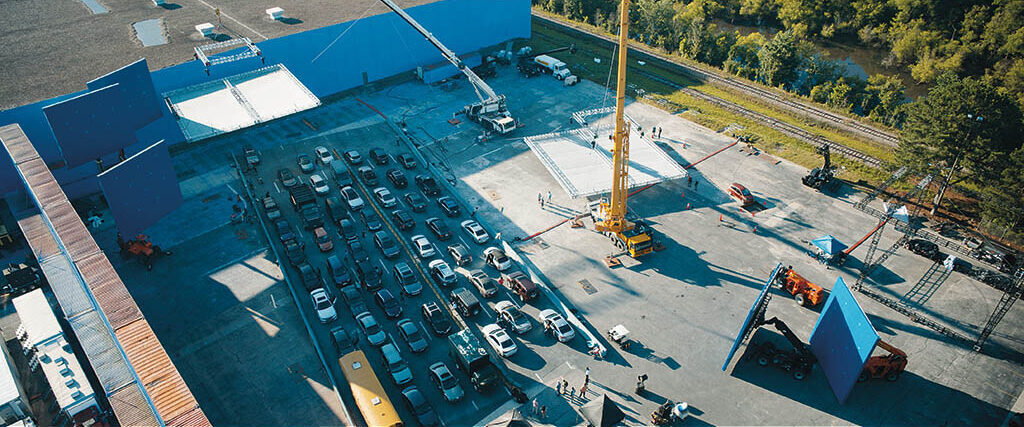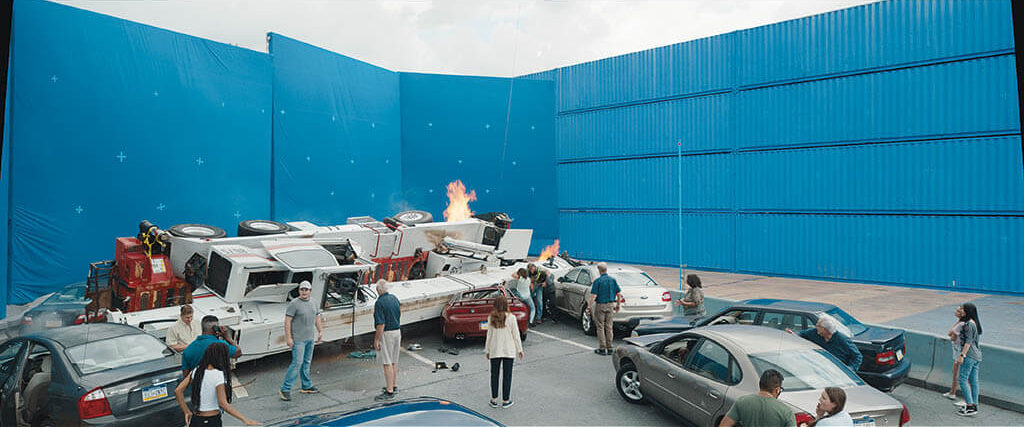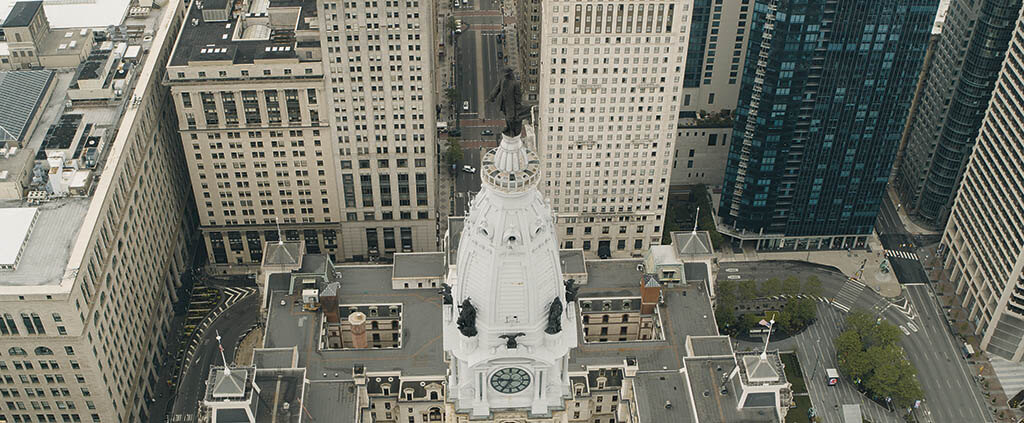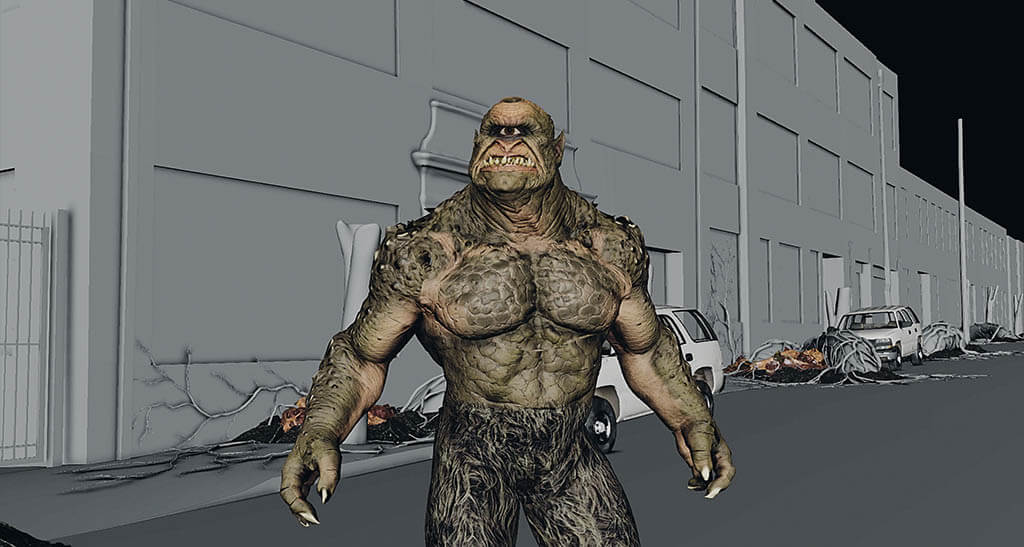By TREVOR HOGG
Images courtesy of Warner Bros. Pictures.
By TREVOR HOGG
Images courtesy of Warner Bros. Pictures.

The chest bolt was a practical lighting element that subsequently had to be replaced in post-production to fit into the suit properly.
Best described as the movie Big with a superhero complex, Shazam! brought an irreverent teenage attitude to the DC Extended Universe where Billy Batson (Asher Angel) and his fellow foster-children friends can transform themselves into adults with extremely heightened abilities and powers. The mix of comedy and action resulted in a worldwide box office of $366 million. Filmmaker David F. Sandberg has returned along with a cast of Asher Angel, Zachary Levi, Jack Dylan Grazer, Adam Brody, Djimon Hounsou, Faithe Herman, Meagan Good, Ian Chen and Ross Butler for Shazam! Fury of the Gods.
“In the first movie, Shazam [Zachary Levi] broke the Wizard’s [Djimon Hounsou] staff, which was the gateway for the bad guy to have the power,” explains Bruce Jones (Reminiscence) who, along with Raymond Chen (Togo), served as co-visual effects supervisor for the sequel. “In this story, the Wizard’s staff had imprisoned gods from Greek mythological times, so when Shazam broke it, he released three daughters of Atlas who have come back for revenge on mankind because human wizards had imprisoned them. They plant a seed from the god realm that grows into a giant tree in our world. Roots sprout throughout the city of Philadelphia and these seed pods burst open, releasing manticores, minotaurs, harpies and cyclops that terrorize the fine folk of Philadelphia. Our heroes come to the rescue and fight these evil powers until they ultimately overcome them.”

Lucy Liu’s character Kalypso rides the dragon, so there was a lot of hydraulic buck shooting that happened on set.
“[The cyclops] is quite a Ray Harryhausen cyclops, which I appreciate. The minotaur has what looks like armor plates growing out of its flesh and skin. The harpies look humanoid around the face and are the creepiest creature that we did. Then, of course, they have wings and feathers. The manticore was our most complex creature. The head is like a lion, but at the same time it’s scaly and has a crocodile mouth, bat-like wings and a scorpion’s tail.”
—Thrain Shadbolt, VFX Supervisor, Wētā FX
Certain effects were carried over into the second installment of the franchise, which consists of just under 2,000 visual effects shots. “The way Shazam fires electricity bolts was a look that had been developed by MPC,” Jones states. “This had new suit designs and bolts that looked partly electrified and metallic. Early on, David Sandberg did concepts of creatures that were built with ZBrush and had turntables of them. Those were our guides. Our special effects team, led by J.D. Schwalm, built big mechanical bucks for the unicorns that our heroes ride. The dragon was primarily DNEG and Pixomondo supplemented 100 shots. Wētā FX handled a lot of the mythological creatures. Scanline VFX looked after the Benjamin Franklin Bridge sequence. RISE did big, beautiful environments like the Realm of Gods that takes place on Mount Olympus and the Library of Eternity, which is this endless library where the flocks of books fly around. Method Studios was responsible for when Hespera (Helen Mirren) and Kalypso (Lucy Liu) enter the Acropolis Museum in Athens, which has the broken staff on display. We had BOT VFX and Stereo 3D enhancing 400 bolts on the costumes, an in-house company called Hollywood VFX did a ton of look development and Territory Studio created the motion graphics.”

Anthea (Rachel Zegler) has the Power of Axis, which is the ability to manipulate the world around her.

The daughters of Atlas, Hespera (Helen Mirren) and Kalypso (Lucy Liu), escape from the broken magical staff of the Wizard Shazam (Djimon Hounsou) and reassemble the ancient relic to wreak havoc on humanity.

Ross Butler as Super Hero Eugene, Adam Brody as Super Hero Freddy, Grace Caroline Currey as Super Hero Mary, Zachery Levi as Shazam, Meagan Good as Super Hero Darla and D.J. Cotrona as Super Hero Pedro.


A portion of the Benjamin Franklin Bridge was created in the parking lot at Blackhall Studios.
A physical chest-bolt appliance on Shazam meant to provide Cinematographer Gyula Pados with interactive lighting proved to be problematic. “It would go on top of the metal chest bolt. Then, being LED, there was some foam on top of that to cast a soft light on the underside of the chin,” Chen reveals. “This added quite a bit of bulk to the chest, and, in some cases, it protruded quite a bit. There were a large number of shots where we had to take out the appliance, put in the CG version of the glowing bolt and fix everything. There were shots where the entire chest was replaced. It was a lot more shots than we had anticipated.” Other practical elements worked quite well. “We had a number of dragon shots, and one of the things that we worked out with J.D. Schwalm was an industrial robot that he actually used on Black Adam, which was originally built to move around car chassis. We programmed it to have the motion of the dragon so that Lucy Liu’s character, Kalypso, could actually ride it, as the more traditional six-pistol hexapod motion bases didn’t have enough travel for us for some of the shots. We went through and pre-animated the scenes, converted the files, worked out some of the motion, and basically filmed those. Those actually worked out quite well to get the interactivity of Lucy reacting to the movement of the motion base. For an actor, it’s hard to fake that real physical act of being tilted.”
Omnidirectional carts were constructed for the unicorns. “They could have 1,000-pound payload on them, and it allowed us to have essentially a mechanical unicorn rig that would replicate the backbone and neck and follow the same motion for a walk and run,” explains Schwalm. “Each cart had an effects operator on it. With a remote control you could drive them left, right, back, spin them around, bring them all into a circle, do their dialogue, peel out and take off running down the stage with the actors on it.”
Principal photography took place in Atlanta, which is receptive to film productions. “We got to do a lot of neat stuff right in the middle of downtown, and even got road closures on some busy intersections to do that stuff,” Schwalm says. “Three cars were flipped at the same time, with one of them going over the top of the others.” A complex gag that required robotics and motion control cameras was having the dragon crush a motorhome in front of the young adult actors. “We had to time the speed at which the dragon crushed the motorhome with the speed of the dragon in the previs,” Schwalm notes. There is no lack of breakaways. “In the underground warehouse, we had a huge number of breakaways consisting of concrete ceilings and floors, walls and shelving units as Shazam is getting thrown around like a rag doll,” Schwalm adds.
Ladon, the dragon that protects the Tree of Life, had to go through design modifications. “The creature was originally designed with small or evenly spaced limbs so the front and back legs are the same lengths, but as soon as we got into this lioness motion, a lot of that power needed to come from the front. So we started building the character up with a much bigger chest and longer front limbs, and then started getting into the length of the neck and size of the head,” explains Russell Bowen, VFX Supervisor at DNEG. “Ultimately, the dragon was still the same size, but the proportions were manipulated so we could get a more powerful creature out of it and a much more elegant adult dragon.” A major environmental element is the Power of Axis, which is an ability that belongs to Atlas’ daughter Anthea (Rachel Zegler). “Anthea can manipulate the world around her. It almost has this kaleidoscope feel where everything starts to become like a puzzle piece that starts to rebuild itself, and she can move a building from one place to another. The city build of Philadelphia had to be detailed, including interiors. Obviously, you can’t do that for every single building, so we had to come up with a robust procedural way of building a massive city on a large scale that was as close as we could to the real thing, because if it doesn’t look like Philadelphia then everyone is going to know that it’s CG.”
Not everything is associated with Greek mythological mayhem as is the case of Benjamin Franklin Bridge where a wayward crane smashes into a Jersey rail [barrier] causing a disastrous domino effect. “This whole sequence is like a short film,” observes Joel Delle-Vergin, VFX Supervisor at Scanline VFX. “The set itself was a carpark at Blackhall Studios where we added a zipper rail and had Jersey rails on both sides.
“The city build of Philadelphia had to be detailed, including interiors. Obviously, you can’t do that for every single building, so we had to come up with a robust procedural way of building a massive city on a large scale that was as close as we could to the real thing, because if it doesn’t look like Philadelphia then everyone is going to know that it’s CG.”
—Russell Bowen, VFX Supervisor, DNEG


The smoke coming from the damaged cars was digitally added by Scanline VFX.


A major environmental element for DNEG was creating the roots from the Tree of Life spreading throughout Philadelphia.

Ladon the Dragon is made out of wood just like the Tree of Life that he protects.

Hespera (Helen Mirren) creates a forcefield dome around Philadelphia that creates a lightning-in-a-bottle scenario for the trapped Shazam.

The proportions of Ladon the Dragon were manipulated by DNEG to get a more powerful, elegant adult creature.


The design of the Cyclops was inspired by stop-motion animation icon Ray Harryhausen.
Then, the rest of it is bluescreen. Each day would have its own set pieces as to where these cars are, and we could change the direction of the cars for the other lanes. We used The Third Floor’s Cyclops, which is like Simulcam, to see the bridge in the shot to make sure that eyelines were correct.” The bridge had to be photoreal and dynamic. Delle-Vergin explains, “Everything down to the rivets was built, and the bridge is moving the whole time. It ended up being almost 200 million polygons. It had to be constructed in a way that was modular enough so it could be like a puzzle piece, in order to be flexible and detailed enough for effects to pull it apart to reflect the different stages of destruction.” Another major build was the surrounding environments. “We had a small team that we took to Philadelphia for a lot of the additional plates and reference photography. The Bridge alone, we ended up shooting around 20,000 photos worth of Roundshot photography that we used to construct the surrounding river and cityscapes,” adds Delle-Vergin adds.
Around 760 shots were spread over DNEG facilities in Vancouver, Montreal, Toronto and Mumbai. “We had those conversations at the beginning, conceptualizing a dragon that is made out of wood and breathing fire, but it’s magical fire, so it works!” laughs Christine Neumann, VFX Producer at DNEG. “The bigger thing turned out to be the reshoot where the third act got redone. Then you get new plates and have an entirely new segment that you need to plan out all of a sudden and fit in.” A particular shot comes to mind for Neumann. “I would talk about DB7120, which was shot where Shazam punches the dragon in the face and it’s in slow motion just because we couldn’t fit in the timeline and had to get creative in production on how to schedule it. There was a plate for Shazam where he does a backflip, and that’s what we got in the reshoot. He was in this rig and they flipped him around. It ended up being 95% CG.”
Referring back to the stop-motion animation icon is the design of the cyclops. “He is quite a Ray Harryhausen cyclops, which I appreciate,” remarks Thrain Shadbolt, VFX Supervisor at Wētā FX. “The minotaur has what looks like armor plates growing out of its flesh and skin. The harpies look humanoid around the face and are the creepiest creature that we did. Then, of course, they have wings and feathers. The manticore was our most complex creature. The head is like a lion, but at the same time it’s scaly and has a crocodile mouth, bat-like wings and a scorpion’s tail.” Extensive simulates were generated to depict the giant seed pods from the Tree of Life that give birth to the mythological creatures. “There is an outer skin to the pod which is rough and an inner membrane that is more like a lot of babies. In between those, you have another set of fluid simulations. We had to start with the animated creature and then we had to simulate the initial interior layer of the pod. Then, the other layer begets the other layer, and then we had to simulate the fluids in and around those as well. Then, there was dirt on the outside of the pod, so there would be a rigid body simulation for that. Each creature had its own birthing moment, and the actions within those were bespoke for the shot and creature.”
“You probably wouldn’t think that heavy visual effects would be the most difficult work,” states Chen. “For example, we used LED screens on the school rooftop, but we needed to replace a large number of them. We were shooting with multiple cameras on set, so you couldn’t get two cameras to have the right perspective, and the color and look of the sky weren’t necessarily right. We did a lot of sky replacement on stuff that we shot on LED screens. There is a lot of fine work in terms of roto, hair and integration. The end sequence is satisfying because it’s a nice final battle between Shazam and Kalypso. The destruction is fun, but it’s also visually quite striking in the nighttime setting and using the lightning to illuminate things.” Getting the proper interaction for things that didn’t exist in reality was difficult.
Schwalm was kept busy every day because of the scope of the work. “[I’m looking forward to] the bridge sequence and when the monsters are running wild downtown,” he says. “I’m excited about the scene that takes place in that underground warehouse with Shazam going through all the concrete walls. That is going to look neat.”